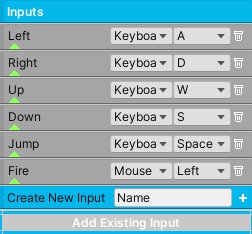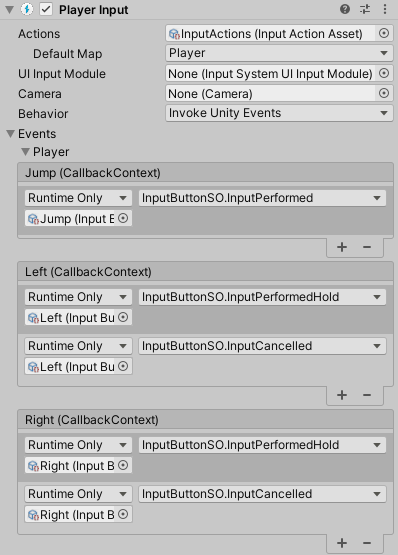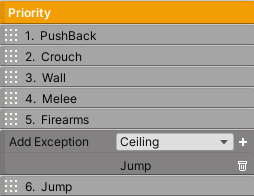Player
The player is the centerpiece of your game, and as such, the engine provides plenty out of the box customizable abilities. To get started, add a BoxCollider2D and a Player component. The Player class will handle the input, abilities, and world collision settings. You will also need to add a RigidBody2D to keep Unity happy, and set Body Type to Kinematic.
Method |
|
|---|---|
BlockInputs(bool value) |
This will block player input if true. |
Inputs
The system has two ways of dealing with inputs. By default, the system implements the old input system, which works with keyboard, mouse, and UI buttons. In the second, the system can interface with the new input system. Both ways require the use of InputButtonSO, which is a scriptable object that acts as a wrapper for both ways of dealing with input. These are created automatically and placed in the AssetsFolder/Inputs each time you create an input with Create New Input. You will need to reference this folder from time to time incase you want to setup UI buttons and other similar functionality.
The system will create common inputs for movement, jumping, and firing, and it will expect the Left, Right, and Jump inputs to always exist. The inputs you see in the inspector are directly linked to an InputButtonSO.
Inputs in the default input system also have the ability to bind to other inputs. For example, if the jump input is bound to another input,then each time this other input goes true, the jump input will also go true. To bind inputs simply click the bottom triangle toggle and start adding them. You will need to set the InputButtonSO reference. These inputs can also change their Keyboard and Mouse values during runtime, and the system will automatically save these changes using PlayerPrefs. This will not working if you are using the new input system.

Inputs |
|
|---|---|
Name and Type |
Pick the type of input, Keyboard or Mouse and set its value. |
Bind Inputs |
The references to the bound inputs. |
Note
Pressing the delete button will simply remove the Input from the player’s input list. You must delete them manually to get rid of them. You can also drag and drop existing inputs into the drop area.
InputButtonSO |
Methods |
|---|---|
ButtonPressed() |
This will set input pressed as true. |
ButtonHold() |
This will set input hold as true. |
ButtonReleased() |
This will set input released as true and will set input hold as false. |
Holding() |
Returns true if the input is being held. |
Pressed() |
Returns true if the input is pressed. |
Released() |
Returns true if the input is released. |
OverrideKeyboardKey (KeyCode newKey) |
Override the keyboard key. |
OverrideMouseKey (int newKey) |
Override the mouse key. 1 == Left. 2 == Right. 3 == Middle. |
You will also notice that some player abilities have a setting called Button Trigger. This setting allows you to choose when an input becomes true.
On Hold
On Press
On Release
Always
Never
Active
Always and Never are primarily used for AI weapons. Setting it to never will prevent the weapon from being fired accidentally by player input, and setting it to always will mean the input is always true! Active means the input is being Held or Pressed via method call. Otherwise use Hold, Press,and Release.
In order to interface with the new input system, install the package through the Packet Manager if it’s not installed already. By default, Flare Engine uses the old input system and if you disable it, you will get an error. So, in Project Settings/Player set Active Input Handling to Both.
Next, add the Player Input component to the Player’s gameobject and set the reference to an InputActionAsset. Demo1 already has this setup and you can find this asset in the Demo/Assets folder. It contains some default values mapped to a generic controller. However, there’s still a good chance the default settings won’t work depending on your controller, in which case you need to open InputActions and bind your specific controller inputs. You will need to refer to Unity documentation to get familiar with this process.
Next, on the Player Input set Behavior to Invoke Unity Events. Open the events foldout as well as the action maps. In this case, it’s called the Player. Then connect InputButtonSO to these events and call the following methods:
New Input System |
Methods |
|---|---|
InputPerformed() |
This will set input pressed as true. |
InputPerformedHold() |
This will set input hold as true. |
InputCancelled() |
This will set input released as true and will set input hold as false. |

For instance, to get an input to behave like a button press just call InputPerformed() as seen by the Jump Input. However, if you want the input to behave like a button hold, call both InputPerformedHold() and InputCancelled() as seen by the movement inputs. In some instances, you might even call all three methods to get the desired effect. After you complete this setup, the new input system will now be in charge of calling these methods.
Priority
If the player has more than one ability enabled, you will have to assign their priority. This means that if two or more abilities become active at the same time, the ability with the highest priority will execute while the other abilities are cancelled. This is to prevent awkward situations. For example, let’s say that when the player is climbing a wall, the player must not have the ability to shoot its firearm or else a shooting animation might commence. This will look weird if the shooting animation does not account for the wall holding. With the priority system, this can be prevented.

However, it’s sometimes necessary for abilities to coexist. The system implements exceptions for these situations. Any ability can add exceptions, which allows the specified abilities to execute concurrently with it. For example, when the player shoots a firearm, if the Firearms ability does not include the Jump ability as an exception, the player will not be able to fire a projectile and jump at the same time. To remedy this, add the Jump exception to the Firearms priority.
To set a priority, simply drag the priority blocks over each another. Number one is the highest priority.
Tip
If using the PushBack ability, it’s recommended to set it as the highest priority so when the player is damaged, it will disengage from whatever ability it is currently using, like climbing a wall.
Settings
Property |
|
|---|---|
Gravity, Jump |
The jump height and jump time dictate the value of gravity. These values are also found in the jump ability. |
Gravity Multiplier |
This will scale the force of gravity when the player has a negative y velocity. |
Terminal Velocity |
The maximum falling velocity of the player. |
Rays |
The number of raycasts that will extend horizontally and vertically from the character to detect the world. Keep this number low for efficiency. |
Climb Slopes |
If enabled, the character will be able to climb slopes no higher than the max slope. |
Rotate To Slope |
If enabled, the character will rotate according to the rotate rate to be perpendicular with the ground. |
Rectify In Air |
If enabled, and if the character is rotated and jumps, it will rotate to a squared position. |
Jump Through 2D Edge |
If enabled, the character will automatically jump through an Edge Collider 2D without having to hold the jump button. |
Check Corners |
If enabled, the system will check if platform corners are going into the side of the character and prevent it. Note, if Climb Slopes is enabled, the system will automatically check for corners going through the bottom of the character. |
Use Bridges |
If enabled, the character will be able to walk on bridges. |
Use Moving Platforms |
If enabled, the character will be able to interact with moving platforms. |
Collide With World Only |
The system checks for both World and Platform collisions. Enabling this will only check for World collisions. |
Use Late Update |
For AI only. If enabled, the character will execute during Late Update instead of Update. |
Crushed By Platform |
The Unity Event invoked when the character is crushed between two hard surfaces. This happens when the character is standing on or holding a moving platform and is moved into a hard surface, or when the character is pushed into a hard surface. This event typically means a character death, and the character’s position needs to be reset, or else the character will move into a wall and create an ambiguous scenario. Call a World Effect with the dynamic Activate method. |
Edge Collider 2D
When dealing with platforms that contain EdgeCollider2D, the character can jump through a platform if the jump button is being held. Otherwise, the system will interpret the platform as a ceiling. The character can jump down through a platform if the down button is being held. Of course, this can only work if the Jump and Down inputs exist.
Ability
Click the red button to add abilities into the system. Any ability can be paused by calling the Pause method from its component. For convenience, each ability can be paused in the inspector during development.
Creating An Ability
Create a unique ability if the engine doesn’t already provide it. Follow the template below.
using UnityEngine;
namespace TwoBitMachines.FlareEngine.ThePlayer
{
public class Ability : MonoBehaviour
{
// None of the methods below are required. Use them as necessary
public override void Initialize (Player player)
{
// Initialize variables here. This is called in Awake.
}
public override void Reset (AbilityManager player)
{
// Reset important variables here.
}
public override bool TurnOffAbility (AbilityManager player)
{
// This is called when a higher priority ability overrides this one.
// Reset important variables. Usually the Reset method is called here.
// Return false if this ability is doing an important task that can't be cancelled.
// For example, the crouch ability can't be cancelled unless the player has enough
// head room to fully stand up. Return true if it can be cancelled.
return true;
}
public override bool IsAbilityRequired (AbilityManager player, ref Vector2 velocity)
{
// This is where the system checks if the ability has become active. Some condition
// will go true, usually a button is pressed, in which case return true.
return false;
}
public override void ExecuteAbility (AbilityManager player, ref Vector2 velocity)
{
// Place the code that executes the ability here. This is only called if the ability
// is active.
}
public override void EarlyExecute (AbilityManager player, ref Vector2 velocity)
{
// This is always called before ExecuteAbility. Sometimes it's necessary to execute
// code before anything else. The ability itself shouldn't execute here. However,
// if the ability is simple enough and always needs to run, execute the ability here.
// The Ground ability functions this way. If doing this, just make sure the ability
// won't interfere with any other abilities.
}
public override void LateExecute (AbilityManager player, ref Vector2 velocity)
{
// This is always called after ExecuteAbility. Firearm ability uses it to apply
// recoil to the player.
}
public override void PostCollisionExecute (AbilityManager player, Vector2 velocity)
{
// This is called after all the abilities and collision checks have executed.
// This velocity was the total velocity applied to the player during the frame.
}
}
}
// The AbilityManager has many variables to be aware of.
// player.signals -- set relevant signals: player.signals.Set ("signalName")
// player.world -- read if player is onGround, onSlope, onMovingPlatform, etc
// player.inputs -- read button inputs: player.inputs.Pressed("buttonName"), etc
// player.maxJumpVel -- the maximum jump force
// player.onSurface -- set true if the player should be standing on a surface. Bridge uses this
// player.jumpButton -- read if the jump buttons have been pressed
// player.hasJumped -- set true if the ability made the player jump
// player.gravity.gravity -- the value of gravity
// player.checkForAirJumps -- set true if the ability made the player jump
// player.playerDirection -- the direction of the player in the x-direction